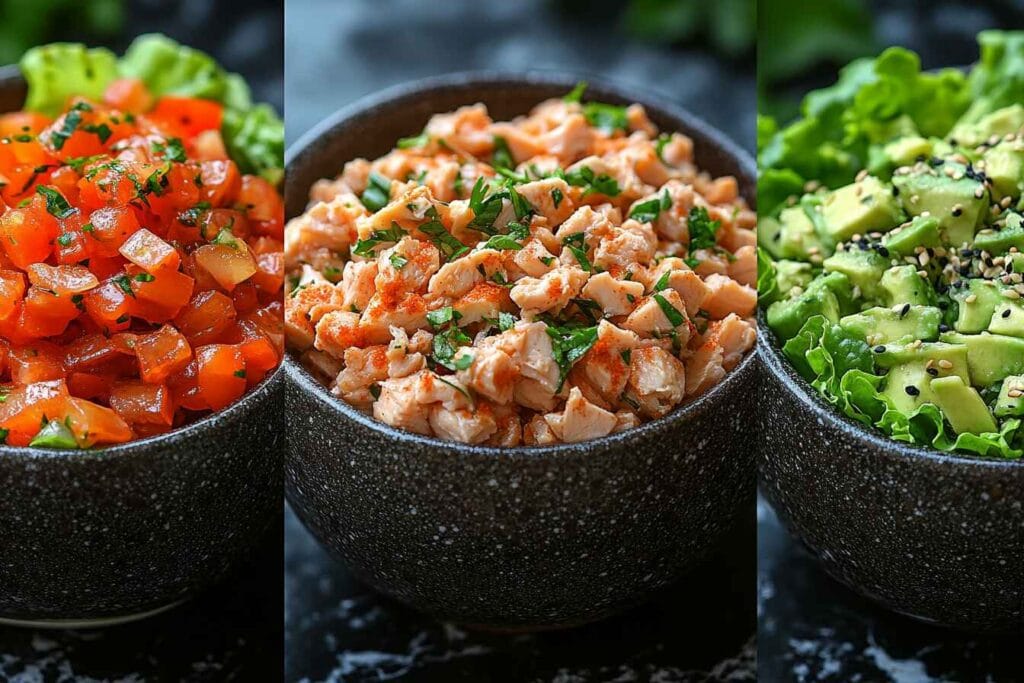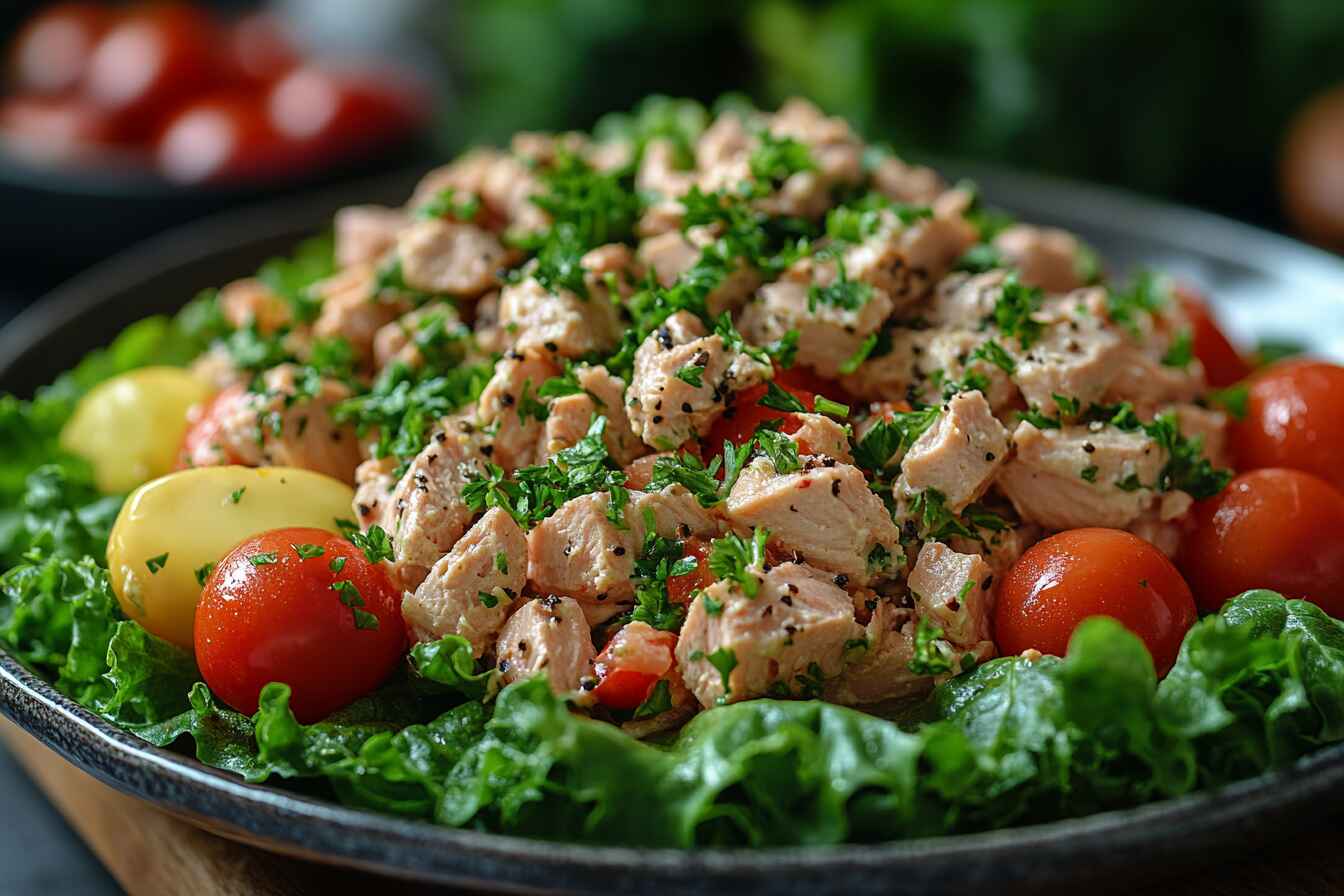Ah, tuna salad! It’s one of those dishes that’s comforting, versatile, and so easy to whip up. But have you ever stopped to wonder how many calories are hiding in your bowl of creamy goodness? Whether you’re trying to eat healthier, lose weight, or simply stay mindful of what you’re eating, understanding the calorie content in tuna salad can make all the difference.
Let’s dive into this topic with a fresh perspective. We’ll explore everything from the ingredients that impact calorie count to tips for making your tuna salad both nutritious and delicious. Get ready to become a tuna salad pro!
Table of Contents
Why Understanding Calories in Tuna Salad Is Important
Calories matter because they’re the fuel your body uses to keep running. But just like you wouldn’t pour diesel into a gas-powered car, the type of fuel you choose (aka your food choices) is super important. Tuna salad might seem like a healthy pick, but hidden calories can creep in if you’re not careful. Think of it like this: each ingredient in your salad is a puzzle piece. Some pieces fit perfectly into a balanced diet, while others can throw off the entire picture.
Tuna Salad: A Nutrient-Dense Meal Option
When done right, tuna salad is more than just a tasty snack—it’s a nutritional powerhouse. Tuna is rich in protein, omega-3 fatty acids, and important vitamins like B12 and D. Add in some crunchy veggies, and you’ve got yourself a bowl of health. However, it’s easy for calorie counts to skyrocket when you add heavy dressings or large portions of calorie-dense ingredients like mayonnaise.
Did You Know? One tablespoon of mayonnaise packs around 90 calories! Swap it for Greek yogurt to save big on calories without losing creaminess.
Breaking Down Tuna Salad Calories
So, what actually goes into a typical tuna salad? Each ingredient plays a role in the calorie game, and some are heavier hitters than others. Let’s break it down step by step.
Calories in Basic Tuna Salad Ingredients
Here’s a closer look at the most common ingredients in tuna salad and how they contribute to the calorie count:
| Ingredient | Calories (per serving) |
|---|---|
| Canned Tuna (packed in water, 3 oz) | 73 calories |
| Mayonnaise (1 tbsp) | 90 calories |
| Celery (1/4 cup) | 4 calories |
| Red Onion (1/4 cup) | 15 calories |
| Dijon Mustard (1 tsp) | 5 calories |
As you can see, some ingredients like celery and mustard barely move the calorie needle. But mayonnaise? That’s where things get serious. This is why portion control and smart ingredient swaps can make a huge difference in your tuna salad’s calorie profile.
Tuna: The Protein Powerhouse
Tuna is the star of the show here. Packed with lean protein and heart-healthy omega-3s, it’s an excellent base for your salad. A 3-ounce serving of tuna (canned in water) contains just 73 calories and over 16 grams of protein. That’s a lot of nutritional bang for your buck! It’s like the MVP of your plate—small in size but big in benefits.
Mayonnaise: A Calorie-Rich Addition
Ah, mayo. It’s creamy, tangy, and oh-so-delicious, but let’s not ignore the elephant in the room: calories. Just one tablespoon of mayo can add a whopping 90 calories. And let’s be honest—most of us probably use more than just a tablespoon. If you’re watching your calorie intake, consider using a lighter alternative like Greek yogurt or a homemade vinaigrette.
Pro Tip: Mix equal parts mayonnaise and Greek yogurt for the best of both worlds—creamy texture with fewer calories.
Vegetables and Mix-Ins: Adding Flavor with Minimal Calories
Crunchy celery, zesty onions, and even a handful of fresh herbs like parsley or dill can elevate your tuna salad without adding many calories. These ingredients are like the backup singers to your tuna’s lead vocals—they make the whole dish shine without stealing the spotlight.
Homemade vs. Store-Bought Tuna Salad: Calorie Comparison
Ever grab a pre-made tuna salad from the grocery store or a deli? While convenient, these options often come with hidden calories. Store-bought versions can be loaded with extra mayonnaise, sugar, or even unhealthy oils. Making your own tuna salad at home not only saves calories but also lets you control the flavor and freshness.
Common Variations and Their Impact on Calories
Tuna salad is like a blank canvas—you can customize it to fit your taste buds and dietary needs. But different variations can significantly impact the calorie count. Let’s explore a few popular options:
Low-Calorie Tuna Salad Options
Stick to lean ingredients like tuna, a touch of light mayo, and lots of veggies. You’ll keep it under 200 calories per serving.
High-Protein Tuna Salad for Muscle Gain
Boost your protein by adding hard-boiled eggs or mixing in some quinoa. Great for post-workout fuel!
Mediterranean-Style Tuna Salad Calories
This version swaps mayo for olive oil and adds kalamata olives, cucumbers, and cherry tomatoes. While still healthy, the olive oil and olives can bump up the calories if you’re not careful.
Keto-Friendly Tuna Salad and Its Calorie Count
Going keto? Use full-fat mayo, avocado, and even some cheese for a rich, creamy salad that’s higher in calories but fits your low-carb goals.
Fun Fact: Adding avocado to your tuna salad not only enhances the flavor but also provides healthy fats for a satisfying meal.
Addressing Common Problems Related to Tuna Salad Calories
Making a healthy and delicious tuna salad might seem simple, but there are a few common pitfalls that can sabotage your calorie goals. Let’s tackle these issues and explore solutions that will keep your tuna salad both tasty and nutritious.
How to Reduce Calories in Tuna Salad Without Sacrificing Taste
One of the biggest calorie culprits in tuna salad is mayonnaise. Sure, it adds a creamy texture, but it’s not your only option! Consider swapping out heavy mayo for these lower-calorie alternatives:
- Greek Yogurt: Adds creaminess with a tangy kick, and it’s packed with protein.
- Mashed Avocado: A heart-healthy fat that adds richness without the processed oils.
- Hummus: A surprising but delightful choice that pairs well with tuna and adds a savory flavor.
By making these swaps, you can save up to 60 calories per tablespoon without compromising flavor. Want to take it a step further? Add herbs and spices like dill, parsley, or paprika to amplify the taste without adding calories. Think of it as dressing up your tuna salad in a calorie-conscious outfit!
Avoiding Hidden Calorie Traps in Pre-Packaged Tuna Salad
Store-bought tuna salads often come with unexpected surprises, like added sugar, excessive sodium, or unhealthy oils. These extras can sneakily increase your calorie count. The best way to avoid these traps is to check the ingredient list and nutrition label. Look for tuna salads made with simple, whole ingredients and minimal additives.
Quick Tip: If the ingredient list is as long as a novel, it’s probably best to pass.
Balancing Tuna Salad with Your Dietary Goals
Whether you’re aiming to lose weight, maintain your current weight, or bulk up, tuna salad can fit into any meal plan. The key is adjusting your ingredients and portion sizes to align with your goals. For weight loss, stick to lean proteins and low-calorie dressings. For muscle gain, add calorie-dense but nutrient-rich ingredients like nuts, seeds, or even a drizzle of olive oil.
Tips for Making a Healthy Tuna Salad
Ready to level up your tuna salad game? Here are some practical tips to help you create a dish that’s as healthy as it is delicious.
Choosing the Right Tuna: Fresh, Canned, or Packed in Water
Not all tuna is created equal. When choosing your tuna, consider the following options:
- Fresh Tuna: Great for a gourmet twist but requires cooking. It’s naturally low in calories and high in protein.
- Canned Tuna in Water: The best choice for a low-calorie option. A 3-ounce serving has just 73 calories.
- Canned Tuna in Oil: Rich in flavor but higher in calories due to the oil. Drain it well if you’re counting calories.
If you’re looking for convenience without sacrificing quality, canned tuna packed in water is your best bet. It’s like the Swiss army knife of tuna—it works in almost any recipe!
Using Calorie-Conscious Dressing Alternatives
We’ve already touched on swapping out mayo, but let’s go deeper. Experiment with these options to find your favorite dressing:
- Light Italian Dressing: Adds zest without the heaviness.
- Lemon Juice and Olive Oil: A Mediterranean-inspired option that’s light and refreshing.
- Salsa: Yes, salsa! It’s a low-calorie way to add bold flavors.
Recipe Idea: Mix tuna with lemon juice, olive oil, and a sprinkle of garlic powder for a simple, healthy dressing.
Adding Nutrient-Rich Ingredients to Maximize Value
Boost the nutritional profile of your tuna salad by adding ingredients that are low in calories but high in nutrients:
- Leafy Greens: Spinach or kale adds volume and vitamins.
- Chopped Veggies: Bell peppers, cucumbers, and carrots add crunch and color.
- Fresh Herbs: Dill, parsley, or cilantro can enhance the flavor profile without adding calories.
Think of your tuna salad as a canvas, and these ingredients are your palette. Get creative and add a variety of colors and textures to make your meal as visually appealing as it is tasty.
Solutions for Portion Control and Calorie Management
Even the healthiest tuna salad can derail your diet if you’re not mindful of portions. Here’s how to keep things under control:
Measuring Ingredients for Accurate Calorie Counting
Use measuring cups and spoons to portion out your ingredients. This simple step ensures you’re not accidentally doubling up on high-calorie components like mayonnaise or cheese.
Using Food Tracking Apps for Tuna Salad Recipes
Apps like MyFitnessPal or Cronometer can be lifesavers for tracking your meals. Input your recipe, and they’ll calculate the calorie count for you. It’s like having a personal nutritionist in your pocket!
Pro Tip: Save your favorite tuna salad recipes in the app for quick and easy tracking next time.
Frequently Asked Questions About Tuna Salad Calories
Still have questions? Let’s clear up some common queries about tuna salad and its calorie content.
How Many Calories Are in a Typical Serving of Tuna Salad?
A standard serving (about 1/2 cup) of homemade tuna salad typically ranges from 150-250 calories, depending on the ingredients used. Store-bought versions may have higher calorie counts due to added fats and sugars.
Can Tuna Salad Fit Into a Weight Loss Diet?
Absolutely! With the right ingredients and portion sizes, tuna salad can be a low-calorie, high-protein meal that keeps you full and satisfied. Just be mindful of calorie-dense add-ins like mayo or cheese.
Is It Better to Use Greek Yogurt Instead of Mayonnaise?
Yes, especially if you’re watching your calorie intake. Greek yogurt has fewer calories and more protein, making it a healthier alternative. Plus, it adds a tangy flavor that pairs perfectly with tuna.
Conclusion: Making the Most of Tuna Salad in Your Diet
By now, you’ve got a solid understanding of tuna salad calories, how to manage them, and ways to make this classic dish healthier and more delicious. Whether you’re a fan of the traditional mayo-based recipe or love experimenting with creative twists, tuna salad is a versatile meal that can fit into almost any diet.
The key is balance. By being mindful of your ingredient choices and portion sizes, you can enjoy tuna salad without any guilt. It’s all about making smart swaps, adding nutrient-rich ingredients, and tailoring the recipe to meet your personal health goals.
Summing Up Key Takeaways
- Watch the mayo: It’s the biggest calorie contributor in most tuna salads, but easy swaps like Greek yogurt or hummus can lighten the load.
- Portion control is key: Even healthy ingredients can add up if you’re not measuring them properly.
- Customize your salad: Add low-calorie, high-nutrient ingredients like leafy greens, fresh herbs, and crunchy veggies to maximize flavor and nutrition.
- Stay mindful with store-bought versions: Always check labels for hidden sugars, fats, and unnecessary additives.
Pro Tip: Make your tuna salad fresh at home to have complete control over the calories and ingredients!
Inspiring Ideas for Your Next Healthy Tuna Salad
Now that you’re armed with all this knowledge, it’s time to get creative! Here are some fun and healthy tuna salad recipes to try:

Classic Tuna Salad with a Healthy Twist
Combine canned tuna (packed in water), Greek yogurt, a squeeze of lemon juice, diced celery, and chopped parsley. Add a pinch of salt and pepper to taste. Serve it over a bed of mixed greens or in a whole-grain wrap for a light lunch.
Spicy Avocado Tuna Salad
Replace mayo with mashed avocado and mix it with your tuna. Add a dash of hot sauce, some diced jalapeños, and a sprinkle of cilantro for a spicy kick. Serve with whole-grain crackers or cucumber slices for a low-carb snack.
Mediterranean Tuna Salad
Skip the mayo and use olive oil and lemon juice as your dressing. Toss in cherry tomatoes, cucumber slices, red onion, Kalamata olives, and a sprinkle of feta cheese for a Mediterranean-inspired feast. Serve it in a pita pocket or over quinoa for a hearty meal.
Low-Carb Tuna Salad Lettuce Wraps
Mix your tuna with a little Dijon mustard, Greek yogurt, and diced pickles. Scoop it into large romaine lettuce leaves, and you’ve got a satisfying low-carb meal that’s perfect for lunch or dinner.
| Recipe Name | Calories (Approx.) | Main Ingredients |
|---|---|---|
| Classic Tuna Salad | 200 per serving | Tuna, Greek Yogurt, Celery, Parsley |
| Spicy Avocado Tuna Salad | 250 per serving | Tuna, Avocado, Jalapeños, Hot Sauce |
| Mediterranean Tuna Salad | 300 per serving | Tuna, Olive Oil, Feta Cheese, Vegetables |
| Low-Carb Tuna Salad Lettuce Wraps | 150 per serving | Tuna, Dijon Mustard, Pickles, Lettuce |
Tips for Meal Prepping Tuna Salad
If you’re looking to save time during the week, tuna salad is an excellent choice for meal prepping. Here’s how to keep it fresh:
- Store it in an airtight container: This keeps the flavors locked in and prevents it from drying out.
- Hold off on adding veggies: Ingredients like cucumbers or tomatoes can release water and make your salad soggy. Add them just before serving.
- Make single-serving portions: Divide your salad into individual containers to make it easy to grab and go.
Storage Tip: Homemade tuna salad can last in the fridge for up to 3 days when stored properly.
Your Turn: Create Your Perfect Tuna Salad
With all these tips, tricks, and recipes, the ball is in your court. Whether you’re meal prepping for the week, making a quick snack, or experimenting with new flavors, tuna salad is a dish that never gets boring. Remember, it’s not just about calories—it’s about creating a meal that’s balanced, delicious, and tailored to your lifestyle.
So, what’s your favorite way to enjoy tuna salad? Try one of the recipes above, or create your own signature version. Either way, you’re now fully equipped to make the most of this versatile dish. Happy cooking!

